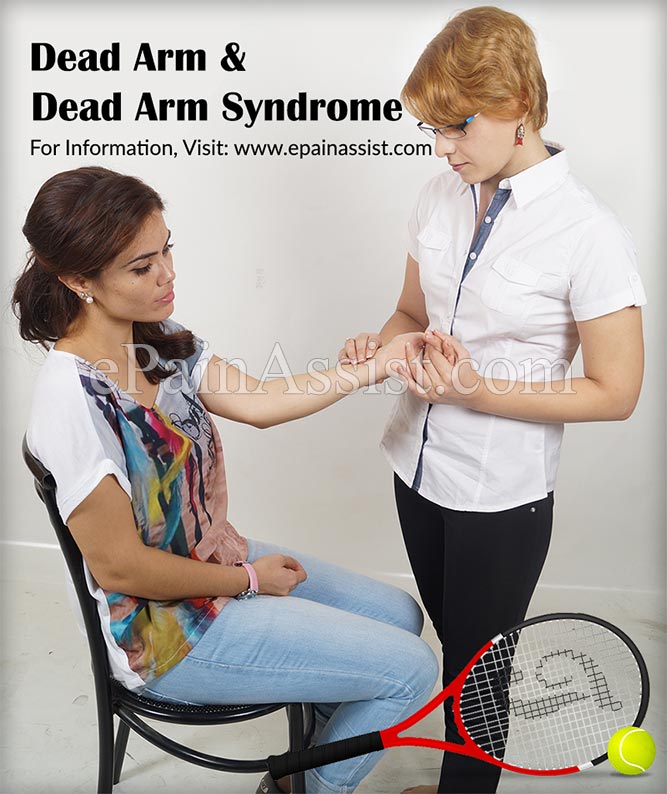What is a Dead Arm?
Dead Arm is a condition or a feeling where there is temporary loss of sensation or movement in the arm. A person can commonly experience a dead arm after waking up in the morning after sleeping in the wrong position, such as on the arm, or when keeping the arm hanging from the chair for some time. The inability to move the arm or feel anything in the arm occurs from nerve compression, nerve damage or when a nerve gets stretched. A dead arm can be reversed by doing some simple exercises, which will help in regaining the arm function and puts life into a “dead” arm.

Simple Exercises to Relieve Dead Arm
Swinging the Arms: Swinging your arms in different directions and moving them as much as possible helps in relieving the nerve compression and also allows the blood to flow more easily in the arms.
Massaging the Arms: Massage increases blood flow and stimulates nerves in the arms which allow the dead arm to “wake up.”
Lifting the Arm Above the Head: Lifting the arm above the level of the head helps in stretching the compressed nerve and also stimulates the nerve. This will help in regaining the function of the affected arm.
What is a Dead Arm Syndrome?
“Dead Arm Syndrome” is a medical condition where a person experiences an abrupt pain, which can be paralyzing or sharp in nature with numbness in the arm. This occurs when there is a direct blow/injury to the shoulder or if there is forcible movement of the shoulder to maximum external rotation in elevation. A person experiencing a dead arm will not be able to move the affected arm and is not able to perform a throwing movement with the type of velocity and control, which was present before the injury. This condition is also referred to as recurrent transient subluxation of the shoulder. The other common characteristics of a Dead Arm Syndrome usually include damaged anterior labrum and anterior instability of the shoulder, which can occur because of subluxation of the head of the humerus.
What are the Causes of Dead Arm Syndrome?
Young athletes aged between 20 to 30 years tend to suffer from dead arm syndrome as their arms usually undergo powerful hyperextension in elevation along with external rotation of the shoulder. There are different causes for a dead arm syndrome. Common causes include:
- One of the common causes for dead arm syndrome is repetitive forceful throwing, such as seen while serving in tennis.
- Working with the arm placed in a strained position above the level of shoulder can also cause dead arm syndrome.
- Problems or damage to the labrum or rotator cuff can also cause dead arm syndrome.
- Posterior capsular contracture or instability of the shoulder can also cause dead arm syndrome.
- Other than this, dead arm syndrome can also occur due to calcification in the ball and socket joint, impingement of the shoulder ligaments, bone spurs in the acromion, micro-instability, biceps tendonitis, SLAP lesion and internal impingement.
- Psychological conditions can also play a part in the occurrence of dead arm syndrome.
What are the Symptoms of Dead Arm Syndrome?
Sudden pain in the arm, numbness and inability to move the arm are the common symptoms of Dead Arm Syndrome. Loss of the posterior rollback can also worsen the symptoms, which results in anterior translation and causes increased internal impingement posteriorly.
How to Differentiate Dead Arm Syndrome from Other Shoulder Problems?
Dead Arm Syndrome can be mistakenly diagnosed for a cervical lesion or shoulder pathology. Features that differentiate Dead Arm Syndrome from other problems include the age of the patient, as the Dead Arm Syndrome is commonly seen in young athletes aged between 20 to 30 years. Patient has a history of powerful shoulder overextension. Other than this, there is also positive apprehension test with relocation.
How is the Diagnosis of Dead Arm Syndrome Made?
Patients with Dead Arm Syndrome will have a positive apprehension test, which is carried out with the patient in a lying or standing position. Patient’s shoulder is moved passively where it is maximally externally rotated and in abduction. Forward pressure is then applied to the posterior side of the head of the humerus. The test is considered positive if the patient complains of shoulder pain, becomes apprehensive suddenly, and feels as if the shoulder is about to come out its joint.
If the apprehension test is not positive, then consideration should be given to other conditions, which can cause shoulder disability.
What is the Treatment of Dead Arm Syndrome?
Treatment for Dead Arm Syndrome is similar to that of labrum injuries and shoulder instability. Surgery could be required to rectify the instability and to repair the injured glenoid labrum. After the pain and inflammation have subsided, then patient should gradually return to a throw program. This can take about four weeks.
Patient should have complete range of motion and flexibility in the shoulder joint before commencing strengthening exercises, such as resisted internal rotation, abduction of the shoulder and external rotation. All these exercises help in strengthening the rotator cuff muscles, which are responsible for stabilizing the humeral head. This exercise regime should be done for about four months and it helps in reducing pain and disability.
Surgery is needed if the Dead Arm Syndrome progresses to postero-superior impingement with development of SLAP lesion. Arthroscopy is done to repair the SLAP lesions.
